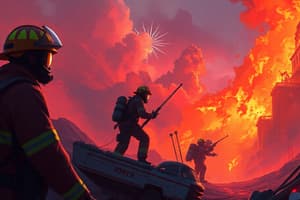Podcast
Questions and Answers
What is the most critical factor that search teams must prioritize during search and rescue operations?
What is the most critical factor that search teams must prioritize during search and rescue operations?
- Using multiple hoselines for protection
- Locating victims as quickly as possible
- Ensuring the safety of search crew personnel (correct)
- Avoiding any exposure to smoke
What type of exposure primarily increases with proximity to the fire for fire victims?
What type of exposure primarily increases with proximity to the fire for fire victims?
- Chemical exposure
- Physical trauma
- Radiation exposure
- Thermal exposure (correct)
In non-residential fire operations, how should firefighters conduct their search?
In non-residential fire operations, how should firefighters conduct their search?
- Conducting solo searches in isolation
- With a single officer directing a large team
- Operating off of a hoseline
- Not operating off of a hoseline (correct)
What should be done before entering the search area to ensure effectiveness?
What should be done before entering the search area to ensure effectiveness?
Why is the floor level considered the most survivable space during a fire?
Why is the floor level considered the most survivable space during a fire?
What is a crucial consideration for maintaining the safety of the search crew during operations?
What is a crucial consideration for maintaining the safety of the search crew during operations?
Why might floors in multi-story buildings provide a good reference for search teams?
Why might floors in multi-story buildings provide a good reference for search teams?
In terms of search plan execution, how should individual search activities typically be conducted?
In terms of search plan execution, how should individual search activities typically be conducted?
What should Company Officers focus on during search operations?
What should Company Officers focus on during search operations?
What precaution should be taken when conducting searches that expose crews to fire conditions?
What precaution should be taken when conducting searches that expose crews to fire conditions?
Flashcards are hidden until you start studying
Study Notes
Search and Rescue Procedures
- Search and rescue operations must prioritize the safety of personnel while effectively locating victims.
- Key objective is victim recovery, avoiding actions that may lead to additional casualties among the search crew.
- Fire victims face threats from thermal exposure (heat) and toxic exposure (smoke and combustion products).
- Proximity to the fire increases thermal exposure risk; toxic exposure risk is linked to smoke presence rather than distance from the fire.
- The safest area to find potential survivors in a structure is typically at floor level due to heat rising.
Search Team Preparation
- All team members must understand the specific search plan before entering the search area, including objectives, assigned areas, and individual responsibilities.
- A pre-search meeting among crew members enhances communication and operational clarity.
Search Operations Guidelines
- It is advisable for individual search activities to involve two or more members for safety.
- During residential searches, firefighters may operate away from the hoseline; for non-residential structures, adherence to hoseline use is critical for safety.
- Conducting a brief survey of the floor below the fire can assist with orientation and strategy, as multi-story buildings often share similar layouts.
Safety Measures
- In environments with potential fire conditions (especially above the fire floor), search teams should be protected by a charged hose line to mitigate risks during operations.
- Company Officers should maintain awareness of each crew member's position and function to ensure cohesive and safe operations during the search.
Search and Rescue Procedures
- Search and rescue operations must prioritize the safety of personnel while effectively locating victims.
- Key objective is victim recovery, avoiding actions that may lead to additional casualties among the search crew.
- Fire victims face threats from thermal exposure (heat) and toxic exposure (smoke and combustion products).
- Proximity to the fire increases thermal exposure risk; toxic exposure risk is linked to smoke presence rather than distance from the fire.
- The safest area to find potential survivors in a structure is typically at floor level due to heat rising.
Search Team Preparation
- All team members must understand the specific search plan before entering the search area, including objectives, assigned areas, and individual responsibilities.
- A pre-search meeting among crew members enhances communication and operational clarity.
Search Operations Guidelines
- It is advisable for individual search activities to involve two or more members for safety.
- During residential searches, firefighters may operate away from the hoseline; for non-residential structures, adherence to hoseline use is critical for safety.
- Conducting a brief survey of the floor below the fire can assist with orientation and strategy, as multi-story buildings often share similar layouts.
Safety Measures
- In environments with potential fire conditions (especially above the fire floor), search teams should be protected by a charged hose line to mitigate risks during operations.
- Company Officers should maintain awareness of each crew member's position and function to ensure cohesive and safe operations during the search.
Studying That Suits You
Use AI to generate personalized quizzes and flashcards to suit your learning preferences.




